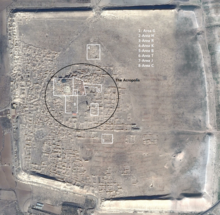 A satellite image of Qatna with the archaeological sites marked | |
| Alternative name | Tell el-Mishrife تل المشرفة |
|---|---|
| Location | al-Mishrifeh, Homs Governorate, Syria |
| Coordinates | 34°50′06″N 36°51′57″E / 34.83500°N 36.86583°E |
| Type | Settlement |
| History | |
| Founded | c. 3300 BC |
| Abandoned | 1982 AD |
| Periods | Bronze Age, Iron Age |
| Cultures | Amorite, Aramean |
| Site notes | |
| Excavation dates | 1924, 1927–1929, 1994, 1999–2011 |
| Archaeologists | Robert du Mesnil du Buisson, Michel Al-Maqdissi, Daniele Morandi Bonacossi and Peter Pfälzner |
| Condition | Ruined |
| Ownership | Public |
| Public access | Yes |
| Website | http://www.qatna.de/ |
Qatna (modern: Arabic: تل المشرفة, Tell al-Mishrifeh; also Tell Misrife or Tell Mishrifeh) was an ancient city located in Homs Governorate, Syria. Its remains constitute a tell situated about 18 km (11 mi) northeast of Homs near the village of al-Mishrifeh. The city was an important center through most of the second millennium BC and in the first half of the first millennium BC. It contained one of the largest royal palaces of Bronze Age Syria and an intact royal tomb that has provided a great amount of archaeological evidence on the funerary habits of that period.
First inhabited for a short period in the second half of the fourth millennium BC, it was repopulated around 2800 BC and continued to grow. By 2000 BC, it became the capital of a regional kingdom that spread its authority over large swaths of the central and southern Levant. The kingdom enjoyed good relations with Mari, but was engaged in constant warfare against Yamhad. By the 15th century BC, Qatna lost its hegemony and came under the authority of Mitanni. It later changed hands between the former and Egypt, until it was conquered and sacked by the Hittites in the late 14th century BC. Following its destruction, the city was reduced in size before being abandoned by the 13th century BC. It was resettled in the 10th century BC, becoming a center of the kingdoms of Palistin then Hamath until it was destroyed by the Assyrians in 720 BC, which reduced it to a small village that eventually disappeared in the 6th century BC. In the 19th century AD, the site was populated by villagers who were evacuated into the newly built village of al-Mishrifeh in 1982. The site has been excavated since the 1920s.
Qatna was inhabited by different peoples, most importantly the Amorites, who established the kingdom, followed by the Arameans; Hurrians became part of the society in the 15th century BC and influenced Qatna's written language. The city's art is distinctive and shows signs of contact with different surrounding regions. The artifacts of Qatna show high-quality workmanship. The city's religion was complex and based on many cults in which ancestor worship played an important role. Qatna's location in the middle of the Near East trade networks helped it achieve wealth and prosperity; it traded with regions as far away as the Baltic and Afghanistan. The area surrounding Qatna was fertile, with abundant water, which made the lands suitable for grazing and supported a large population that contributed to the prosperity of the city.
